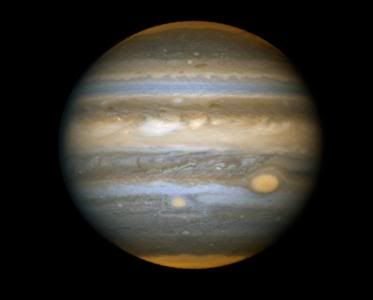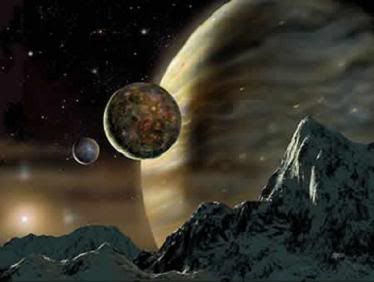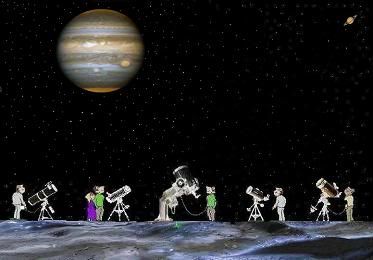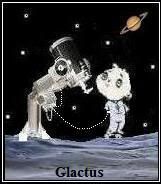Post by glactus on Sept 26, 2011 0:27:29 GMT
Jupiter has the fastest rotation of all the planets in the Solar System, completing one rotation on its axis every 9.9 hours. It sounds like a simple question: what’s the rotation of Jupiter? But finding out the answer was surprisingly complicated.

The Planet Jupiter
Why was it so difficult to figure out Jupiter’s rotation? Unlike the inner terrestrial planets, Jupiter is a ball of almost entirely hydrogen and helium. Unlike Mars or Mercury, Jupiter has no surface features that you track to measure the rotation speed; there are no craters or mountains that rotate into view after a specific amount of time.

Jovian moons
Jupiter's speed is quite a feat when you consider its size. it’s turning a lot of mass very quickly. The rapid rotation causes the planet’s equator to bulge out. Instead of being a perfect sphere, Jupiter looks more like a squashed ball. The bulge at the equator is even visible in small, backyard telescopes.

Space art- The Astronomy club lookung at Jupiter
This bulge dramatically effects the diameter of Jupiter, depending on whether you measure it from the center of Jupiter to the equator or to the poles. The polar radius of Jupiter is 66,800 km, while the equatorial radius is 71,500 km. In other words, points along Jupiter’s equator are actually 4,700 km more distant from the planet’s center.
Jupiter is a ball of gas, and so it actually experiences differential rotation. The rotation takes different amounts of time depending on where you are on the planet. The rotation of Jupiter at its poles takes about 5 minutes longer than the rotation of Jupiter at its equator. So the commonly quoted 9.9 hours is actually an average amount for the entire planet
To see quality 7 minute and 30 second movie of Jupiter's high rotational speed and its effect on the Jovian moons just click on the link below. Has sound.
www.youtube.com/watch?v=s56pxa9lpvo

Credits: These are non copywrite images
Text by Wikipedia
Space art by Glactus

The Planet Jupiter
Why was it so difficult to figure out Jupiter’s rotation? Unlike the inner terrestrial planets, Jupiter is a ball of almost entirely hydrogen and helium. Unlike Mars or Mercury, Jupiter has no surface features that you track to measure the rotation speed; there are no craters or mountains that rotate into view after a specific amount of time.

Jovian moons
Jupiter's speed is quite a feat when you consider its size. it’s turning a lot of mass very quickly. The rapid rotation causes the planet’s equator to bulge out. Instead of being a perfect sphere, Jupiter looks more like a squashed ball. The bulge at the equator is even visible in small, backyard telescopes.

Space art- The Astronomy club lookung at Jupiter
This bulge dramatically effects the diameter of Jupiter, depending on whether you measure it from the center of Jupiter to the equator or to the poles. The polar radius of Jupiter is 66,800 km, while the equatorial radius is 71,500 km. In other words, points along Jupiter’s equator are actually 4,700 km more distant from the planet’s center.
Jupiter is a ball of gas, and so it actually experiences differential rotation. The rotation takes different amounts of time depending on where you are on the planet. The rotation of Jupiter at its poles takes about 5 minutes longer than the rotation of Jupiter at its equator. So the commonly quoted 9.9 hours is actually an average amount for the entire planet
To see quality 7 minute and 30 second movie of Jupiter's high rotational speed and its effect on the Jovian moons just click on the link below. Has sound.
www.youtube.com/watch?v=s56pxa9lpvo
Credits: These are non copywrite images
Text by Wikipedia
Space art by Glactus


